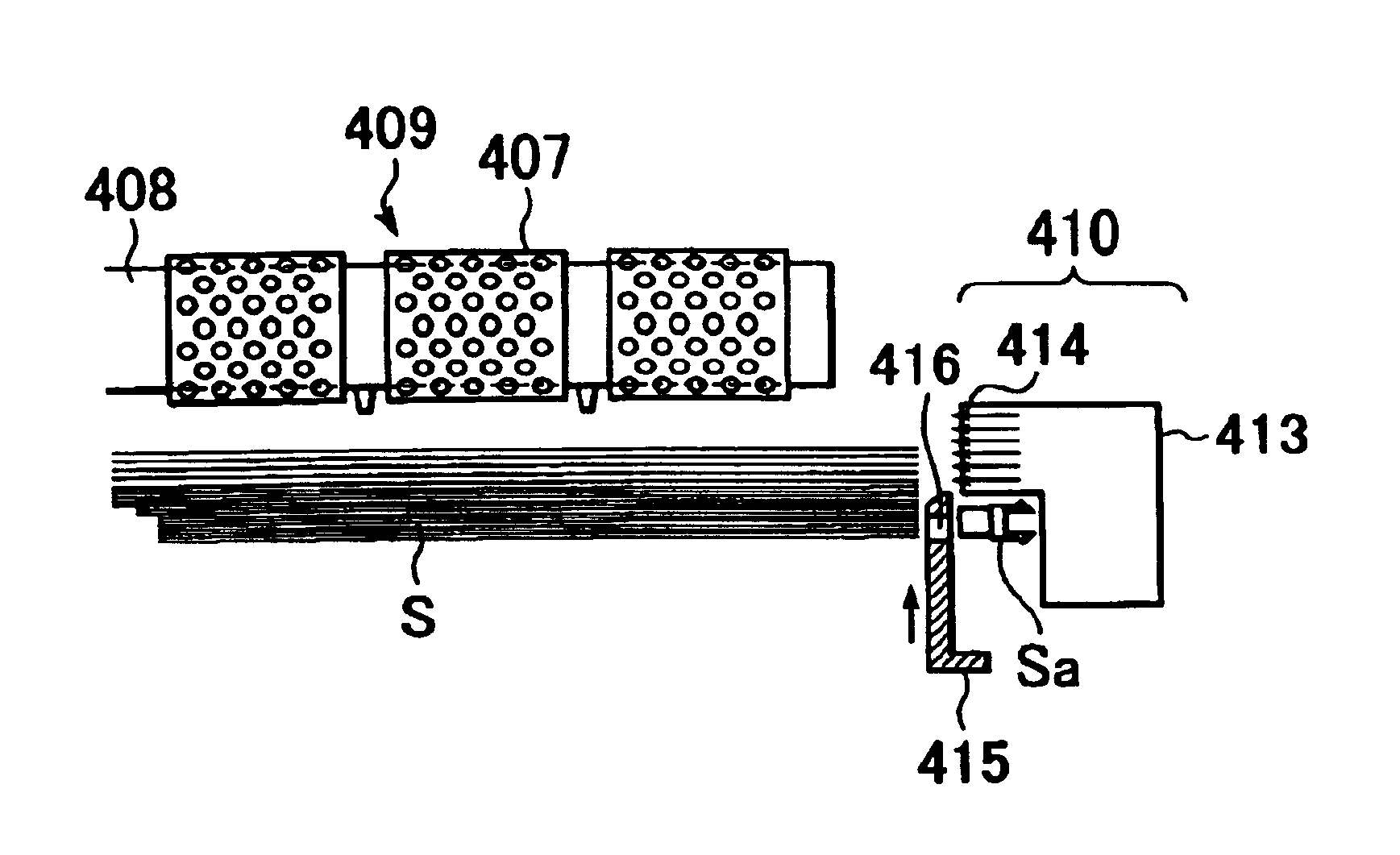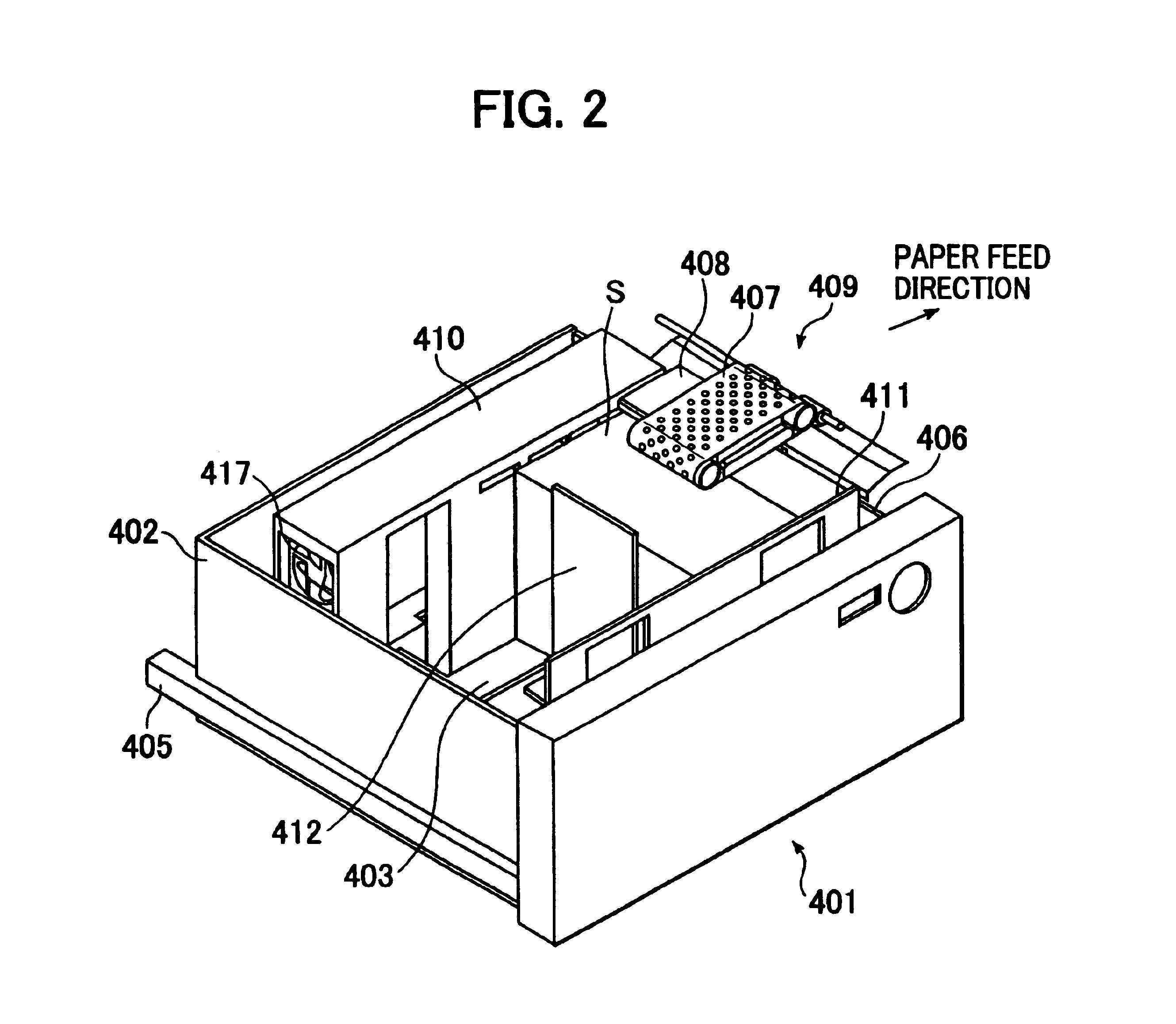Sheet feeder which separates sheets with variable speed and/or direction blown air and image forming apparatus using same
a feeder and variable speed technology, applied in the field of feeders, can solve the problems of surface smoothness, double-feed due to paper-to-paper adhesion rarely occurring, double-feed and/or misfeed, etc., to achieve the effect of reducing the occurrence of sheet-to-sheet adhesion, and reliably eliminating sheet-to-sheet adhesion
- Summary
- Abstract
- Description
- Claims
- Application Information
AI Technical Summary
Benefits of technology
Problems solved by technology
Method used
Image
Examples
second embodiment
[0049]A second embodiment according to the present invention will now be described with reference to FIGS. 5A and 5B. In FIGS. 5A and 5B, the same reference numbers are used to denote the same components as those in the first embodiment, and the description thereof are omitted.
[0050]In this embodiment, a blowing duct 413 and a shutter 415 capable of moving up and down are provided on the front end side of a sheet bundle in the paper feeding direction. A separation duct 418 connected to a separation fan (not shown) has a separation nozzle 419, and it is configured so as to supply separation air in a slanting direction toward the suction belt 407 by the separation nozzle 419. This separation air operates effectively in that it causes only the sheet located in the uppermost position to adhere to the suction belt 407, and separates and lets fall the subsequent sheets.
[0051]In this embodiment, the shutter 415 reciprocates between the uppermost position (FIG. 5A) and the lowermost positio...
third embodiment
[0054]Next, a third embodiment according to the present invention will be described with reference to FIGS. 6A and 6B and FIGS. 7A to 7C. In these figures, the same reference numbers are used to denote the same components as those in the above-described first and second embodiments, and the descriptions thereof are omitted.
[0055]In this embodiment, as shown in FIGS. 6A and 6B and FIGS. 7A to 7C, when the suction belt 407 is driven (i.e., when it is in an on-state), the speed of blown air is set to the vicinity of the minimum speed (see FIG. 7A). The speed of blown air may be varied in accordance with any one of the location of the shutter 415, the magnitude of the blown air supply source, and the cooperation between them. According to this method, paper feed is performed at a timing when the blown air speed is sufficiently low, and therefore, it is possible to provide a sheet feeder that inhibits a double-feed such as to drag the subsequent paper, as described above.
[0056]If, using ...
fourth embodiment
[0058]Next, a fourth embodiment according to the present invention will be described with reference to FIGS. 8A to 8C. In FIGS. 8A to 8C, the same reference numbers are used to denote the same components as those in the above-described first and second embodiments, and the description thereof are omitted.
[0059]In this embodiment, a swing nozzle 421 serving as air direction adjusting means capable of turning the side edge of upper portion of sheet bundle in the up-and-down direction, is provided in the blowing duct 413 disposed on the front end side of the sheet bundle. The swing nozzle 421 continuously blows air on the side edge of the bundle S in an upward direction (see FIG. 8A), substantially in the horizontal direction (see FIG. 8B), and in a downward direction (see FIG. 8C). The swing nozzle 421 blows air while turning in the up-and-down direction, and therefore, with respect to the sheet bundle S, the swing nozzle 421 can give air that continuously varies in air direction, the...
PUM
 Login to View More
Login to View More Abstract
Description
Claims
Application Information
 Login to View More
Login to View More - R&D
- Intellectual Property
- Life Sciences
- Materials
- Tech Scout
- Unparalleled Data Quality
- Higher Quality Content
- 60% Fewer Hallucinations
Browse by: Latest US Patents, China's latest patents, Technical Efficacy Thesaurus, Application Domain, Technology Topic, Popular Technical Reports.
© 2025 PatSnap. All rights reserved.Legal|Privacy policy|Modern Slavery Act Transparency Statement|Sitemap|About US| Contact US: help@patsnap.com



